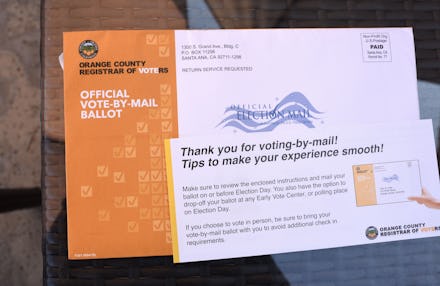California has instituted universal vote-by-mail for the November election

The country's most populous state took a major step forward for voting rights Friday when California Gov. Gavin Newsom (D) signed an executive order to ensure every resident registered voter receives a ballot in the mail ahead of the upcoming November election.
While California is not the first state to commit to a wholesale vote-by-mail option (Colorado, Hawaii, Oregon, Washington, and Utah already conduct their entire elections by mail), it is by far the largest and has the most potential to change the debate over if and how other states can make the transition. Newsom's executive order does keep a number of polling stations open for in-person voting, and it only applies to this upcoming election, directly citing health concerns prompted by the ongoing coronavirus pandemic.
"There’s a lot of excitement around this November’s election in terms of making sure that you can conduct yourself in a safe way, and make sure your health is protected," he explained during a signing event on Friday.
The move toward remote voting in California comes as Democrats in New York State push to reverse a judicial decision allowing the upcoming presidential primary election to move forward, after it was canceled in April. Among the reasons the primary election had been called off in the first place was concern over the coronavirus pandemic — particularly after the debacle that was the Wisconsin primary, during which dozens of people contracted the virus as a result of participating in the election in-person.
New York's state Board of Elections decided to cancel the presidential primary after voting to remove Vermont Sen. Bernie Sanders's name from the ballot, leaving former Vice President Joe Biden as an uncontested candidate. But the decision was criticized for disenfranchising New Yorkers, as well as for the fact that only the presidential primary was canceled, meaning anyone who wanted to vote in the state's other elections would still possibly have to vote in person.
While New York Gov. Andrew Cuomo (D) has ordered that any New Yorker who wishes to can request an absentee ballot for the upcoming primary, California's new rule takes that a step further, putting the onus on the state, rather than the voters, to receive their ballots by mail. Mail in voting broadly has become a major issue among election reform advocates, who argue that instituting widespread mail-in-ballots is both a secure and overdue step toward broader voting rights.
President Trump has pushed back on the effort, saying that it "doesn't work out well for Republicans," which is typically true of any endeavor that allows more people to vote.
Incredibly, Trump also defended his own proclivity for voting absentee, saying that "I'm allowed to" when asked during a recent White House briefing about his having voted by mail in Florida's March election, just moments after he called the practice "horrible" and "corrupt."
California's decision to enact vote-by-mail for the upcoming general election is just one of the many ways states, and the federal government, are preparing for what is likely to be an already-contentious election, even without the added anxiety brought on by coronavirus. And there's reason to be optimistic about California's ability to make the transition relatively smoothy: During this past March's primary election, some 72% of all ballots cast were cast absentee according to the Los Angeles Times.
Which isn't to say the process will be easy. The costs and logistics are understandably daunting, and still largely in flux. However, as California Secretary of State Alex Padilla said during Friday's signing ceremony: “It’s great for public health, it’s great for voting rights, it’s gonna be great for participation."